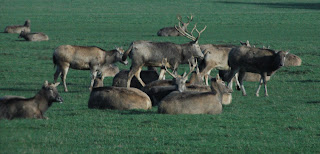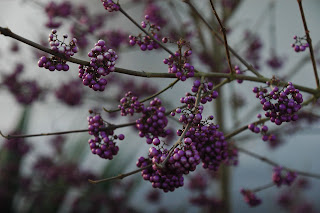A different direction today — Woburn Abbey. This is not far from Milton Keynes, so we're not really trekking about!
The first thing you notice as you approach Woburn Abbey is deer, deer, and more deer! The residence of the Duke of Bedford sits amid a huge 3,000 acre deer park. This is one of the largest conservation parks in Europe. There are more than 1,200 deer, of nine species, including the critically endangered Père David's deer. Within Woburn Abbey Deer Park there are Red Deer and Fallow Deer, which are native to Britain, as well as seven other species which originally came from Asia. These include the Milu, or Père David's Deer, which the 11th Duke helped to save from extinction. The others are the Sika, Axis and Barasingha, and the rare and shy Rusa Deer, as well as small Muntjac and Chinese Water Deer which roam individually.
We got to the entrance, to find that Woburn Abbey itself is closed for the winter, but there is more than enough to do wandering its Gardens, 38 acres of magic! But first we adjourned to the Duchess' Tea Rooms for a morning coffee, and a chance to warm up a little.
Then we went out into the gardens. The gardens are continually being reworked, following the vision of Humphry Repton, Sir Jeffry Wyattville, Percy Cane and Henry Holland. A few parts of the garden were not currently open, or very much not at their best as winter approaches. These included The Kitchen Garden, The Bog Garden (home to many carnivorous plants). the Camellia House, the Cone House and the Hornbeam Maze, but there were numerous sections to interest us...
The Aviary, a recreation of the aviary that existed in the 1830s, part of the menagerie originally designed by Humphry Repton
After walking the gardens, we went into the exhibition hall, and found a beautiful display about the conservation of the Père David's Deer. Herbrand Russell, the 11th Duke of Bedford, realising that the species was extinct in its native China, bought up every specimen from European zoos and nurtured the species at Woburn Abbey. The current world population stems from this herd. The species was reintroduced into China beginning in 1985, and there were about 2000 individuals in deer parks there by 2005. In 1998, due to a flood in the Tianezhou Reserve, some individuals escaped into the wild, and it is estimated that over 700 deer are now living in the wild.
"... it will be a great thing to have such a specimen back in China where its ancestors came from, and where the Milu or Ssu-pu-hsiang may be seenonce more by the Chinese, to whom it haas long been a myth."
Arthur de Carle Sowerby writing to Hastings, the 12th Duke of Bedford
23 October 1947
23 October 1947
Another amazing day. We were driving back towards our old layby when we came across a car park outside Woburn Road Park, fairly close to Woburn Abbey, which proved to be a wonderful place to stop for the night.
Distance driven — today, 21 miles ( 34 km ); to date, 30,905 miles ( 49,737 km )








































A lovely lovelyn day. I love Woburn and the Duke is a shrewd business man. Keep safe and happy, Love Cathy. David said thank you for your kind email for his birthday tomorrow, the 26th.
ReplyDeleteI hope you made lots of deer/dear puns towards Sue, Warren!
ReplyDelete